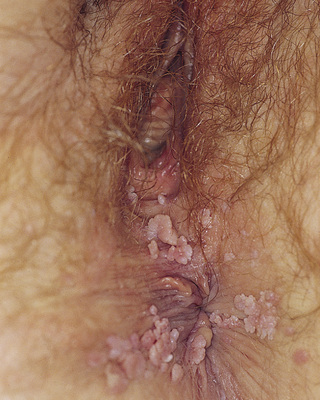Glen Blair Verruca, or warts, are benign epidermal neoplasms caused by various types of the human papillomavirus (HPV), a group of double-stranded DNA viruses of the family Papillomaviridae. More than 200 subtypes of HPV have been identified.1 Roughly 40 of these types affect mucosal surfaces, such as the vulva, vagina, penis, anus, and oral cavity; of these, 16 have been identified as high-risk oncogenic viruses implicated in the development of numerous cervical and anogenital cancers. The other virus phenotypes are apt to affect the nonmucosal cutaneous surfaces, such as the face, hands and feet. Transmission is through direct skin contact, although contact with viral particles on inanimate objects has been known to cause infection. Genital infection is usually acquired through sexual contact. Wart subtypes with an affinity for the hands and feet typically do not affect the genitalia. Individuals with decreased cellular immunity are at risk for more recalcitrant HPV infection. In these patients, warts can be larger and involve a greater surface area. Environmental and occupational factors increase the risk for development of warts. Periungual warts, for example, are much more common in butchers and in patients whose hands are exposed to chronic wet conditions. Recurrence is common for warts of all types. Anogenital HPV infection is believed to be the most common sexually transmitted disease in the United States. Studies have shown that 76% of human immunodeficiency virus (HIV)–seropositive women and 42% of seronegative women are at high risk for anogenital HPV infection, and the rates for HIV-seropositive men who have receptive anal intercourse approach 100%.2 Low-risk types 6 and 11 account for 90% of anogenital warts. The high-risk genotypes are responsible for 99% of the cases of cervical cancer and are emerging as the leading causes of oropharyngeal, vulvar, vaginal, and penile cancers, as well.2 Of these, type 16 is the most common, and type 18 accounts for 70% of all cervical cancers. HPV types 31, 33, 45, 52, and 58 are believed to be responsible for an additional 19% of invasive cervical cancers. There are currently three HPV vaccines available in the United States3: • Cervarix, a bivalent vaccine targeting HPV types 16 and 18 • Gardasil 4, a quadrivalent vaccine targeting HPV types 6, 11, 16, and 18 • Gardasil 9, a nonavalent vaccine targeting HPV types 6, 11, 16, 18, 31, 33, 45, 52, and 58 Each of these vaccines has been shown to induce a significant antibody response. Although there is no national consensus on which vaccine to provide to which patients, the U.S. Advisory Committee on Immunization Practices (ACIP) advocates for the provision of the nonavalent vaccine as the most promising vaccine available to reduce the incidence of HPV-related cancers of all types, because the bivalent and quadrivalent vaccines fail to protect against 25% to 30% of cervical cancers. Vaccination for males and females can begin as early as age 9 but typically begins at age 11 or 12 and up to age 26 in high-risk individuals such as those infected by HIV.3 Infection occurs when the virus comes in contact with skin that is broken or has been traumatized. The virus enters the host’s epidermal epithelial cells and begins to use the host’s resources to replicate. Infection remains contained within the epidermis, although the wart can become hypertrophic and behave as if it were a deep lesion, as it commonly does on the plantar surface. Warts can occur singly or in groups and can coalesce to form plaques called mosaic warts. Autoinoculation can occur with cutaneous trauma, such as from shaving or scratching. Vertical transmission of the virus from infected mother to the fetus during passage through the birth canal can cause anogenital warts and recurrent respiratory papillomatosis in the infant. Infection by the wart virus depends on the number of viral particles, the extent of contact, and the host’s cellular immunity. The virus spreads laterally for a considerable distance beyond the line that demarcates the wart from the normal skin. HPV may be actively replicating or may lie in a dormant, latent state. Spontaneous remission may occur in as many as two of three patients within 2 years. Lesions recur when the host’s cell-mediated immunity can no longer hold the virus in check. Incubation periods range from 1 to 8 months. HPV infection is often asymptomatic. When it becomes apparent, it manifests in several different morphologic characteristics. Verruca vulgaris, the common wart, is a skin-colored, hyperkeratotic papule that may occur on the backs of the hands, in periungual areas, and on the knees. Filiform warts are a variant of common warts that are distinguished by their fine, finger-like projections, They typically occur on the face and may be tender. Verruca plana, the flat wart, is commonly seen on the face and extremities in crops of 1- to 2-mm papules that are smooth, flat, and skin colored to brown. Verruca plantaris, the plantar wart, is a skin-colored papule or plaque on the weight-bearing plantar surfaces of the foot and digits; it is often studded with black pinpoint-sized areas that represent thrombosed capillaries. These warts may be extremely tender and interfere with weight bearing. The thickness of plantar warts makes them particularly resistant to multiple treatment modalities. Condylomata acuminata, or anogenital warts, are sexually transmitted and range from unobtrusive, small, skin-colored papules to large, cauliflower-like growths (Fig. 68-1). Warts have also been described on the oral and nasal mucous membranes, conjunctivae, and larynx.
Warts
Definition and Epidemiology
Pathophysiology
Clinical Presentation and Physical Examination
Warts
Chapter 68








